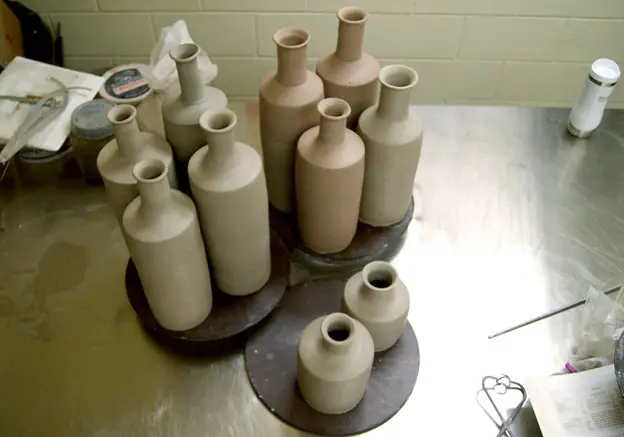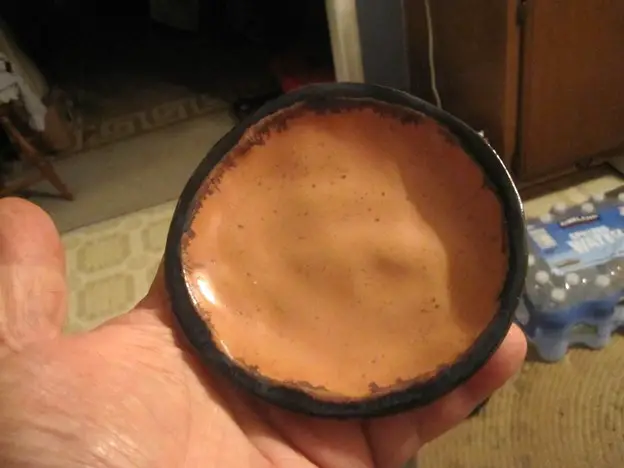When learning the art of pottery, you will learn that clay passes through 4 different and distinctive stages. The very first stage involves plastic-like, soft, and workable clay. In the 2nd stage, the clay is workable but hard like leather. And in the final stage, it becomes dry and hard like bone. Depending on the clay type, there are other drying stages as well.
In this article, we will discuss everything about clay’s leather-hard variant.
So, without further ado, let us decode the basics of this clay and what can be done with it!
Leather Hard Clay: Understanding the Importance
In simple terms, your leather hard pottery clay can be described as a partially dried version of clay. This is because it still carries about 15% water in the overall mixture. This means the clay can still be used for modifications. However, the firmness is enough to ensure that there isn’t any distortion when handled.
This particular clay is highly versatile & can easily be trimmed as per requirement. Further, it can be smoothed, scored, painted, burnished, joined, or even underglaze. However, without the right sculpting tool by your side, it is impossible to achieve perfection with hard leather clay. The best option out in the market for clay sculpting is the Blisstime Sculpting Tool Set. This particular sculpting toolset consists of 30 wooden handle carving tools that do not bend or break down easily.
Also, keep in mind that clay drying is generally divided into different stages, but it is an entire process. Clay tends to dry out gradually and becomes harder in the process. This means you will get access to clay that has matured under different stages of leather hardening.
Clay that reaches the latter stages of firing would be harder than the earlier stages while becoming less workable with time. Clay that falls in the early stages of leathering can easily be altered. The best way to reap benefits from clay leathering is to identify the first point of change when the clay transitions from a soft to a leathery hard one.
When does the clay become leathery hard?
When in its workable, plastic stage, clay consists of 20 to 30 percent water. This water constituent is termed “mechanical water” that sits between the particles of clay. Now, keep in mind that clay starts to shed its water content and dries out when kept out of the sealed packaging. But, how long does it exactly take for the clay to harden up as leathery clay?

Here are some factors that might play a major role in the stage shift process:
- The initial water content when the clay was purchased
- The temperature in your area
- The atmosphere’s humidity level
- Storage of the clay post-use (especially when stored in a drought-like spot)
Apart from the factors mentioned above, it can take about 1 to 3 days on average for the clay to turn hard in its leathery form. If you happen to leave a fresh piece of clay out in the open, it will even harden in a day. Further, if the day records a higher temperature with direct sunlight falling on the clay, the drying time would lessen.
However, if you do not want your clay to crack, the ideal way to dry it out is by covering it with plastic. This slows down the drying and reduces any likelihood of cracking. Also, keep in mind that thinner sections tend to dry way faster than thicker parts, so cover these parts with a thicker plastic layer.
How to tell if your clay has attained the leather-hard stage?
As explained above, leather clay still packs in a certain amount of water. This means, when you hold it, it will feel cold. However, the stickiness of the first stage of clay would no longer be felt. Even if it has enough moisture, the quantity isn’t sufficient for plasticity and stickiness.
The best way to test the leather clay is to hold the clay and check if you leave any fingerprints. If you do leave a fingerprint, the clay is still at its initial stage. Plus, a leather hardened stage would make the clay look darker than normal. When it is bone dried, the color generally becomes lighter.
However, this visual identification point would be pointless in case you have been working with white or light tan clay. Another trick in the book that can be tried to identify clay is to place the clay in a newspaper piece. Leave it on the paper for about one hour or more. If it has a good amount of moisture, you can see a damp patch present on this paper after lifting it up.
Apart from this, if you can see the dusty and pale layer present in the pottery, you can confirm that the clay has entered its third stage and doesn’t represent leather clay anymore.
Here is a quick table that would help you differentiate hard leather clay from any other form by noticing its properties.
| Clay Stages | Type | Features & Drying Stage |
| Slip | Liquid | It is a cream-like liquid created from the combination of water and clay meant to join the clay pieces together |
| Plastic | Malleable | At this stage, the clay is moldable to various shapes or can be manipulated without breaking or tearing |
| Leather Hard | Strong & Durable/Damp & Cold | Now, the clay starts to dry but still contains a good amount of moisture. It can still be joined together or carved into. However, it can’t be manipulated |
| Bone Dry | Fragile | This stage of clay drying doesn’t have any moisture in it. The clay at this stage is at normal room temperature |
| Bisque | Porous/Sturdy | This is a ceramic ware pottery item that has undergone an initial firing process at low temperatures. It still maintains the porosity |
| Glaze Fired | Finished and Non-Porous | This is a stage at which the glaze material melts & forms a coating over the clay’s surface |
Can hard leather clay be glazed?
Well, glazing the hard leather clay could be a wrong move and might affect the shelf life of your pottery piece. As water leaves the clay piece during the kiln firing process, you have to ensure that the resulting clay is taken out in its driest possible version.
This ensures that the glaze that is put on the pottery item stays as it is for a long. As per potters, it is recommended that you need to leave your clay to completely dry out to the bone-dry stage before the glazing process starts.
If you fail to do this, the drying process continues even with the glaze on, which could lead to the shedding of the glaze and chipping with time.
Conclusion
Leathery clay can be used in many pottery item manufacturing processes which makes it versatile. It allows the potters a scope to tidy out and decorate the work. Further, it can be used as a sculpting form to introduce different styles and designs. The leather clay can be softened back to its initial level if a recreation of the pottery item is needed.







